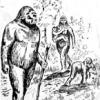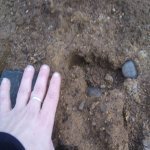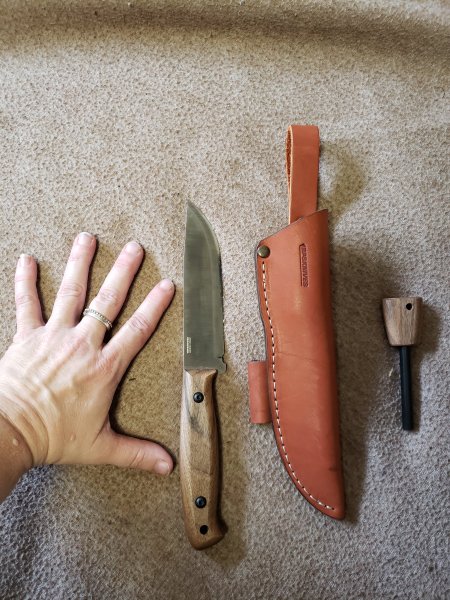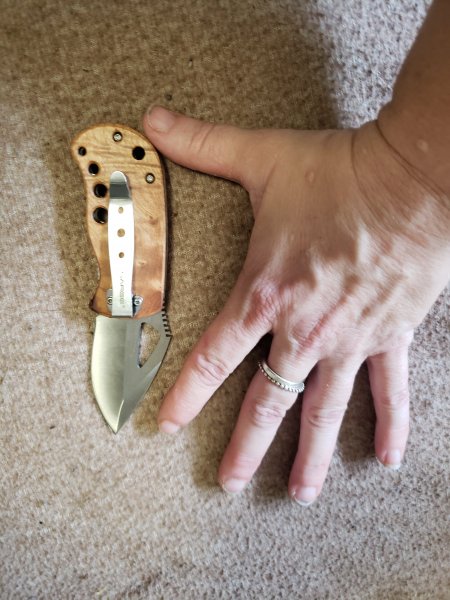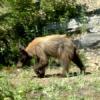Leaderboard
Popular Content
Showing content with the highest reputation on 02/05/2022 in all areas
-
I don't really have a name or a description but I have these:3 points
-
Thank you for this. I had not seen that article, nor the mention of any name, just UCLA as an institution. I will definitely reach out to her asap. Mireya Mayor does public science/citizen science at FIU, so that's likely how they got connected. So much will depend upon the quality and size of found sequences, which is impossible to judge from the scant comments in media outlets, although they clearly at least feel comfortable concluding genus, so I'd be cautiously optimistic that something more could be established. I hope they are willing to share the full data, at least at some point. My colleagues and I will very soon be examining supposedly morphologically anomalous physical samples collected by individuals. At least for the foreseeable future, we will NOT being doing eDNA studies. If you or others in the Forums have potentially interesting physical samples in hand, You know how to reach me.2 points
-
If you wouldn't mind sharing the name and contact info with me, I'd love to reach out to this person at UCLA. I have emailed Dr. Mayor to try to get the sequence data, but imagine with her events schedule it may take a long time to hear back. If so, my email is dcorcutt@ncsu.edu It is actually quite likely that the sequence data could be used to answer the question of whether the eDNA sample contains DNA from an actual chimpanzee or just a very close relative. Depending on how large and clear the sequence(s) are, I wouldn't be surprised if one of my colleagues could identify it to a specific location and family group on a map, as chimpanzee populations are well-documented. One of my colleagues can literally tell an individual chimpanzee's place of birth within 30 miles using only the DNA of microorganisms in scat.2 points
-
Bought myself a full tang knife. I love my Marttiini, but I'm afraid of breaking it if I process wood with it, so. I found this online, from the Ukraine, from a new company called BPS Knives. It is big, with a 5-inch blade, but the handle is small for my small hands. I was eyeballing a different knife but I'm liking this one a lot, surprisingly. The sheath is lovely and hangs under my pack waist belt, which is a perfect fit. Time to go bushcrafting! I also picked up this little thing at Duluth Clothing store and it might be nice for carving.2 points
-
You and me both, Huntster. And yeah, the DNA front has been frustrating but it's application to the Hairy One hasn't been consistent. Dr. Hart has the right idea, just go out where something has occurred and sample some kind of medium. But time plus the cost of sequencing, even though there may be workarounds, is a deal breaker for many.2 points
-
These very rare mutations that are spoken of in this thread should have a name and/or specific description, who can find that out? Lets not relax until we post those up.2 points
-
I would appreciate any help in filling out my knowledge of any attempted genetic studies of alleged Sasquatch samples. What I am aware of: -the Sykes study, which was peer reviewed and published, -the self-published Ketchum et al. study, -that Todd Disotell's lab at NYU looked at some samples from time to time, most in connection with a media production (and results apparently *only* reported in media productions, no publications) -the recent Expedition Bigfoot finding of supposed chimpanzee DNA, sequenced at UCLA (again, released only as a broad result in media, no publication) -a few other analyses that have been reported only in media productions (I know, for example, that Monster Quest used a commercial lab for at least one analysis in addition to coordinating on others with Todd Disotell) -at least a couple amateur BF investigators have reported to me sending samples to commercial labs (I have been sent at least a couple of these analyses by folks who were looking for help in understanding them) -Haskell Hart is currently examining eDNA sequences he's had run by a commercial lab (is anyone else attempting this?) Beyond this, there seem to be some rumored analyses that I can't actually confirm were even conducted, and there seem fairly widespread hearsay of results of "unidentified primate" being received, but I cannot find any actual source of such a finding - though maybe something was presented that way at some point on a TV program? What am I missing? Has anyone here conducted or commissioned DNA analyses of alleged Sasquatch samples? (Even if they turned out to be identifiable as something else). I would love to know, please. Thank you all in advance for your help!1 point
-
Dear BFF Members, The Forum Management Team proposed and the Steering Committee approved releasing the raw SSR Dataset to the community in order to facilitate independent research. The SSR database will always be available if you need to use its capabilities, but we have received requests for the raw dataset many times in the past, so here it is. There will be regular releases posted in this thread as more data is classified. Attribution to "The Bigfoot Forums" is required for any published analysis. We hope it helps somebody advance the search. Thanks, ~gigantor Data Fields Date <MM/DD/YYYY> - MM = {01..12}, DD = {01..31}, YYYY = {0001..9999} Time <hh:mm> - hh = {00..23}, mm = {00..59} Duration <mm:ss> - mm = {00..99}, ss = {00..59} Latitude <floating point> Longitude <floating point> Altitude (ft) <floating point> State <string(2)> County <string(30)> Height (ft in) <string(10)> Footprint Size (inches) <string(10)> Organization <string(30)> Researcher <string(30)> Season: (mutually exclusive - can only select one) 1 - Spring (Mar 20 - Jun 19) 2 - Summer (Jun 20 - Sep 19) 3 - Fall (Sep 20 - Dec 19) 4 - Winter (Dec 20 - Mar 19) Type: (mutually exclusive - can only select one) S - Single Creature M - Multiple Creature N - Non Visual T - Trace Evidence Witness: (mutually exclusive - can only select one) 1 - Single, no evidence 2 - Multiple, no evidence 3 - Single, evidence 4 - Multiple, evidence Witness Activity: (mutually exclusive - can only select one) A - ATV B - BFing C - Camping D - Driving (road) E - 4 Wheeling (off-road) F - Fishing G - Hiking H - Horseback I - Hunting J - Boating / Canoeing / Kayaking N - Normal Activity at Home P - Playing (children) S - Swimming BF Activity: (inclusive, can select any) E - Eating F - Food Gathering H - Hunting K - Knocking O- Objects Thrown P - Speech R - Road Crossing S - Standing T - Stalking V - Vocalization W - Whistling X - Swimming Disposition: (inclusive, can select any) A - Aggressive C - Curious I - Indifferent R - Scared S - Surprised Locomotion: (inclusive, can select any) C - Crawling G - Gliding J - Jogging R - Running W - Walking O - On all fours Terrain: (mutually exclusive, can select one) B - Beach C - Cave D - Desert F - Rain Forest H - Wooded Hill M - Mountainside P - Pasture / Crop Field S - Swamp W - Wooded Plain Zoning: (mutually exclusive, can select one) A - Agricultural C - City M - Commercial P - Park Land / Refuge R - Rural S - Suburb Print Evidence: (mutually exclusive, can select one) TP - Print (1) TS - Track (1) TM - Track (2+) TC - Print (1) + Cast TT - Track (1) + Cast TN - Track (2+) + Cast Photo Evidence: (mutually exclusive, can select one) PF - Photo Film PD - Photo Digital PI - Photo Infrared PN - Photo Night Vision MF- Motion Film MT - Motion Tape MD - Motion Digital MI - Motion Infrared MN - Motion Night Vision Biological Evidence: (inclusive, select any) B - Blood D - Dermal Print F - Feces H - Hair T - Tissue R - Remains Hair Color (mutually exclusive, can only select one) B - Black D - Dark Brown G - Green N - Brown O - Orange R - Red Y - Yellow W - White Skin Color (mutually exclusive, can only select one) B - Black G - Gray N - Brown W - White Weather (inclusive, select any) S - Sunny P - Partly Cloudy O - Overcast R - Rain L - Sleet F - Fog N - Snow W - Wind Moon Cycle (exclusive, can select one) 1 - New Moon 2 - Waxing Crescent 3 - First Quarter Moon 4 - Waxing Gibbous 5 - Full Moon 6 - Waning Gibbous 7 - Last Quarter Moon 8 - Waning Crescent Other: (inclusive, select any) E - Eye Shine O - Odor L - Lore, indigenous traditions, historical references BFRO Class (mutually exclusive, can select one) A - Class A B - Class B C - Class C URL: <string> Notes on Column Labels NED = Not Exact Date. The date was estimated AGPS = Not Exact GPS. The coordinates were estimated Date = Date the report was entered SDate = Sighting Date URL = Sighting report URL Confidence = Subjective rating by person classifying the report RepScore = Objective report scored using the criteria below1 point
-
As a side note to this thread, I have expressed many times in the past few years that there are more people in academia that are approachable and interested in the Sasquatch subject than anyone realizes. And Mr. Darby Orcutt here has reinforced that point. I've also said that academia needs to know that they are respected and that their knowledge and expertise is supported and needed by us. I hope it encourages more of you as members to reach out to scientists and academia as a whole with your questions so that more of academia knows of us and that as far as this subject goes we are behind them.1 point
-
1 point
-
First of all, I need to welcome you to the BFF and tell you how good it is to have you here and getting involved in this particular aspect of pursuing the truth. The announcement of the Chimp DNA finding was in an article on the Travel Channel which runs the Expedition: Bigfoot series. The article quoted Ms. Miroslava Muringuia Ramos who, though not a geneticist herself, heads up the UC system's program for training citizen scientists, equipping them with e-DNA kits, and taking in their field samples. The citizen scientists in the program also get informed on the results of their tested samples. Since I had a name and a place it was a simple matter of opening a correspondence. It's a cool little story and she was extremely nice to talk with. And since her contact info was public on UC's website I feel comfortable posting it here. I wish you and your colleague much luck on the data. If narrowing down a Chimp's species to a geographical is really possible then maybe contacting the Chimpanzee rescue/refuge outfits in Kentucky (one is around Lexington) may lead to some useful information. Ms. Ramos: mnmunguia@ucla.edu1 point
-
Thanks I see the short thread and will purchase his book, must have lost some space/time with respect to his studies and publications.1 point
-
Dr. Hart @hvhart replied in his Library thread about the rarity: The random occurrence of three rare mutations (7852A, 9083C, and 13209T) in all of these samples is a statistically improbable coincidence." These samples being from the SGP though and not necessarily from the collated samples presented in the table above. Still it gives the identifier for the mutation and statistically improbable designation which usually means less than one percent.1 point
-
The thread where Dr. Hart showed up after being invited onto the Forum by gigantor is in the BFF Library section. It's called the Sasquatch DNA Project: A Failed Study (eBook available on Amazon). He has papers on Dr. Meldrum's Relict Hominid Inquiry site, which is also here on the Forum.1 point
-
Yep sort of like unknowingly walking out onto a frozen lake and falling through, it's all in the application of awareness and familiarity of sequence or sequences of topography.1 point
-
The charts are courtesy of Dr. Haskell V Hart and are in his thread here on the BFF.1 point
-
So you have the code letter names of the genes involved and in one case the heteroplasmic mutation specific to BC which is interesting. I wonder if that latter involves something worthy of further analysis. Will have to study up on that. The not in Genbank or in phylotree reference to the OK and ?unknown samples is interesting and wonder if that would wind up in that wastebasket parts bin called metbank or whatever? Lots of questions and need further understanding of these papers before I can figure others out. Thanks for sharing the charts.1 point
-
I wish the sasquatch hunters using dna and electronic methods all the best, but electronics tend to slay my goat, and dna is turning out to be just as much frustrating to me. I just want to get my eyeballs on one for as many moments as possible.......1 point
-
You got it boss, all grounds cleaned now because of no start, new battery clamps, new ignition switch about to put it all back together. Will require a fuel pump eventually too, got it all ready but testing out the electronic repair first, gotta get there on wheels sometimes to find Sasquatch to use your electronics and dna evidence collection toolkit. And of course while one sits under repair the other is developing emissions related part hiccups. Sort of like bird-dogging BF dna and evidence.1 point
-
1 point
-
The OP did not mention the Margaryan report on Zana which rejected Sykes earlier mention of an unknown marker of African origin. https://onlinelibrary.wiley.com/doi/full/10.1002/ggn2.100511 point
-
This is the gift of the Ketchum project that is regularly disregarded or discounted. I believe that it may well prove to be a key for the future.1 point
-
If including Dr. Sykes study you would like to know of another then this may be of interest. In 2018 Nat Geo ran a documentary called The Lost Kingdom of the Yeti. It involved eight scientists who went to Bhutan four from the UK and four from France. They spoke to the locals there and went on expeditions looking for evidence. One of the scientists from France was Dr. Eva Bellemain who the eDNA expert on the team. They had a sequencer with them and ran some samples collected from footprints they had found in some snow. The test results showed bear. I did email Dr. Bellemain but received no response. As far as I know, she still works at SpyGen collecting and running snow samples to track polar bears. The other, of course, were the soils samples collected by Dr. Meldrum of Idaho State from under the centers of the large nests that were discovered in May of 2015. Dr. Todd Disotell ran the tests and stated that the DNA results showed the normal animals of the region plus degraded Human DNA that was too degraded to show a novel primate. Interestingly enough, when looking over the results of the Ketchum project, Dr HV Hart noted some sample sources from two different regions that showed some identical, very rare, mutations that could suggest something novel and encouraged further sampling as a way to support the findings.1 point
-
New member here. Have been pretty fascinated with Sasquatch for a few years now. I’m not necessarily a full on believer, but I’m 100% open minded to the topic and would like to continue broadening my database of knowledge. I’ve listened to every Bigfoot podcast I can think of, read bfro reports, watched every video of sightings I could find….. I say all of that to say this. 85% of them, I’m very skeptical. However, the other 15% I’ve found VERY interesting.Thus, here I am ha1 point
-
There seems to be some confusion here. The 'boats' are not small skiffs but large commercial vessels 40 to 58 feet long. Sasquatch swim out to the boats while they are anchored up for the night. They do not reek of diesel fuel or gasoline. For those who want to place 'a tool of humans' in the woods, consider using an Oscar Mayer weiner car with a variant of the song..............'the dog Sasquatch love to bite'. Forest comedy can be hard to swallow.1 point
-
SSR Open Dataset (1/1/2022 Release) Entire Dataset: SSR-All-1-1-2022.csv Class A Sightings: SSR-ClassA-1-1-2022.csv Class B Sightings: SSR-ClassB-1-1-2022.csv Report Score 6+: SSR-Repscore=6+_1-1-2022.csv1 point
-
A giant red flag for me. I own a oilfield house in eastern Montana, so I was aware. The northern Cheyenne reservation is in eastern Montana. Not western Wyoming.... https://en.m.wikipedia.org/wiki/Northern_Cheyenne_Indian_Reservation The eastern Shoshone (Snake) and northern Arapaho have a reservation close to the Wind river mountains. https://en.m.wikipedia.org/wiki/Wind_River_Indian_Reservation So why would northern Cheyenne kids be hunting in the Wind river mountains a long ways from home? Very seldom do Indian tribes give reciprocity to non native Indians. One kid is 18 and one is 14. This happened within 2 miles of a pickup truck. Most of the wind river mountains are roadless wilderness areas and not on the reservation anyhow. So Shoshone and Arapaho kids would not have access to the wind river mountains to hunt either. Certainly not Gannett Peak which was mentioned..... Anyhow its a cool story. But its a story.1 point
This leaderboard is set to New York/GMT-05:00

